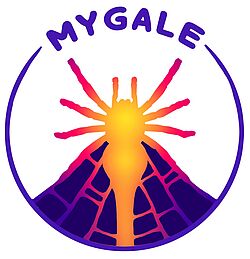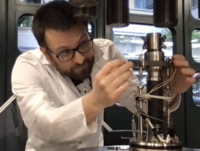

Project summary
Project ANR-21-CE49-0010
Flank collapse represents a significant volcanic hazard. Hydrothermal alteration is considered to promote volcano instability, but there are few data and models to robustly assess this hypothesis. MYGALE is a multidisciplinary and collaborative project that will combine laboratory measurements, geophysical techniques, and modelling to assess the role of alteration on the stability of La Soufrière de Guadeloupe (France). Time-lapse field geophysical measurements will map the extent and evolution of alteration, experiments will provide physical property data for altered rocks and timescales of alteration, and large-scale 4D numerical modelling will assess the influence of alteration on volcano stability by combing the geophysical and upscaled laboratory data. Working closely with the volcano observatory in Guadeloupe, MYGALE aims at designing optimised monitoring networks to better mitigate volcanic hazards. The results of MYGALE will be applicable for hazardous volcanoes worldwide.
MYGALE project coordinator
MYGALE partners
Partner leader: Mike Heap (Institut Terre et Environnement de Strasbourg, ITES)
Partner leader: Marina Rosas-Carbajal (Institut de Physique du Globe de Paris, IPGP)
Partner leader: Caroline Martel (Institut des Sciences de la Terre d'Orléans)
MYGALE team
Institut Terre et Environnement de Strasbourg, ITES
Mike HEAP
Patrick BAUD
Thierry REUSCHLE
Bertrand RENAUDIE
Institut de Physique du Globe de Paris, IPGP
Marina ROSAS-CARBAJAL
Jean-Christophe KOMOROWSKI
Roberto MORETTI
David JESSOP
Vincent ROBERT
Jean-Bernard de CHABALIER
Arnaud BURTIN
Chagnon GLYNN
Institut des Sciences de la Terre d'Orléans
Caroline MARTEL
Laurent ARBARET
Remi CHAMPALLIER
Other named team members
Lydie GAILLER (Université Clermont Auvergne, France)
Albert GILG (Technical University of Munich, Germany)
Tobias BAUMANN (University of Mainz, Germany)
Marlène VILLENEUVE (University of Leoben, Austria)
Additional collaborators
Claire HARNETT (University College Dublin, Ireland)
Alexandra KUSHNIR (EPFL, Switzerland)
MYGALE project goals
MYGALE aims to solve the following:
WP 1 What is the extent of the alteration and how does it change with time? This will be achieved by performing 3D electrical tomography surveys, a geophysical method particularly adept at mapping alteration zones, in each of the four years of the project.
WP 2 How long does it take to alter volcanic rocks? We will perform high-temperature, high-pressure flow-through alteration experiments and measure the mineral content and physical properties of the run products to understand timescales of alteration.
WP 3 What does alteration do to the physical properties of volcanic rocks? We will perform systematic physical and mechanical property analysis of variably-altered (including pristine samples) and variably-porous rocks collected from La Soufrière.
WP 4 How does alteration influence large-scale volcano stability (flank stability modelling combining geophysics and laboratory data)? Using the results from the other three work packages, we will perform large-scale volcano stability models using 3D volcano models created using the electrical tomography data (WP1), including models in which we expand the alteration zones based on our measured alteration rates (WP2), and upscaled physical and mechanical properties (WP3). The results of these models will be used to provide the volcano observatory with valuable information to improve the uncertainty in decision-making on a significant volcanic hazard.
Publications
[13] Heap, M. J., Bayramov, K., Meyer, G. G., Violay, M. E., Reuschlé, T., Baud, P., H. A. Gilg, C. E. Harnett, A. R. L. Kushnir, F. Lazari, and Mortensen, A. K. (2024). Compaction and Permeability Evolution of Tuffs From Krafla Volcano (Iceland). Journal of Geophysical Research: Solid Earth, 129(8), e2024JB029067. https://doi.org/10.1029/2024JB029067.
[12] Leiter, S., J. K. Russell, M. J. Heap, R. W. Barendregt, S. Wilson, B. Edwards (2024). Distribution, intensity, and timing of palagonitization in glaciovolcanic deposits, Cracked Mountain volcano, Canada. Bulletin of Volcanology, 86, 32. https://doi.org/10.1007/s00445-024-01724-w.
[11] M. D. Jackson, M. J. Heap, G. Vola, M. Ardit, J. M. Rhodes, J. G. Peterson, N. Tamura, M. T. Gudmundsson (2024). Material and Mechanical Properties of Young Oceanic Basalt, Surtsey Volcano, Iceland. GSA Bulletin. https://doi.org/10.1130/B37037.1.
[10] Heap, M. J., Harnett, C., Farquharson, J., Baud, P., Rosas-Carbajal, M., Komorowski, J. C., Violay, M.E., Gilg, H.A., & Reuschlé, T. (2023). The influence of water-saturation on the strength of volcanic rocks and the stability of lava domes. Journal of Volcanology and Geothermal Research, 107962. https://doi.org/10.1016/j.jvolgeores.2023.107962.
[9] Heap, M.J., Harnett, C.E., Nazarbayov, T., Heng, Z., Baud, P., Xu, T., Rosas-Carbajal, M. and Komorowski, J.C. (2023). The influence of heterogeneity on the strength of volcanic rocks and the stability of lava domes. Bulletin of Volcanology, 85(9), 49. https://doi.org/10.1007/s00445-023-01669-6.
[8] Heap, M.J., Wadsworth, F.B., and Jessop, D.E. (2023). The thermal conductivity of unlithified granular volcanic materials: The influence of hydrothermal alteration and degree of water saturation. Journal of Voclanology and Geothermal Research, 107775. https://doi.org/10.1016/j.jvolgeores.2023.107775.
[7] Kereszturi, G., Heap, M. J., Schaefer, L.N., Darmawan, H., Deegan, F.M., Kennedy, B., Komorowski, J.-C., Mead, S., Rosas-Carbajal, M., Ryan, A., Troll, V.R., Villeneuve, M., & Walter, T.R. (2023). Porosity, strength, and alteration – Towards a new volcano stability assessment tool using VNIR-SWIR reflectance spectroscopy. Earth and Planetary Science Letters, 602, 117929. https://doi.org/10.1016/j.epsl.2022.117929.
[6] Harnett, C.E., Heap, M.J., Troll, V.R., Deegan, F.M., and Walter, T. (2022). Large-scale lava dome fracturing as a result of concealed weakened zones. Geology. https://doi.org/10.1130/G50396.1.
[5] Heap, M.J., Troll, V.R., Harris, C., Gilg, H.A., Moretti, R., Rosas-Carbajal, M., Komorowski, J.-C., and Baud, P. (2022). Whole-rock oxygen isotope ratios as a proxy for the strength and stiffness of hydrothermally altered volcanic rocks. Bulletin of Volcanology, 84:74, https://doi.org/10.1007/s00445-022-01588-y.
[4] Heap, M.J., Harnett, C.E., Wadsworth, F.B., Gilg, H.A., Carbillet, L., Rosas-Carbajal, M., Komorowski, J.-C., Baud, P., Troll, V.R., Deegan, F.M., Holohan, E.P., and Moretti, R. (2022). The tensile strength of hydrothermally altered volcanic rocks. Journal of Volcanology and Geothermal Research, 428, 107576. https://doi.org/10.1016/j.jvolgeores.2022.107576.
[3] Darmawan, H., Troll, V.R., Walter, T.R., Deegan, F.M., Geiger, H., Heap, M.J., Seraphine, N., Harris, C., Humaida, H., and Mueller, D. (2022). Hidden mechanical weaknesses within lava domes provided by buried high-porosity hydrothermal alteration zones. Scientific Reports, 12, 3202. https://doi.org/10.1038/s41598-022-06765-9.
[2] Heap, M.J., Jessop, D.E., Wadsworth, F.B., Rosas-Carbajal, M., Komorowski, J.-C., Gilg, H.A., Aron, N., Gential, L., Goupil, M., Masson, M., Hervieu, L., Kushnir, A.R.L., Baud, P., Carbillet, L., Ryan, A.G., and Moretti, R. (2021). The thermal properties of hydrothermally altered andesites from La Soufrière de Guadeloupe (Eastern Caribbean). Journal of Volcanology and Geothermal Research, 421, 107444. https://doi.org/10.1016/j.jvolgeores.2021.107444.
[1] Heap, M.J., Baumann, T., Rosas-Carbajal, M., Komorowski, J.-C., Gilg, H.A., Villeneuve, M., Moretti, R., Baud, P., Harnett, C., Reuschlé, T. (2021) Alteration-induced volcano instability at La Soufrière de Guadeloupe (Eastern Caribbean). Journal of Geophysical Research: Solid Earth, 126, 8, e2021JB022514. https://doi.org/10.1029/2021JB022514.

